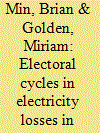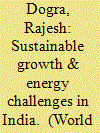| Srl | Item |
| 1 |
ID:
126505


|
|
|
|
|
| Publication |
2013.
|
| Summary/Abstract |
The effective delivery of a sustainable energy future raises many challenges in relation to energy distribution where a new understanding of spatial planning is needed in relation to energy production, consumption and storage. Understanding the emergent low carbon energy economy in terms of its production, distribution and consumption characteristics has prompted a deliberate spatial planning interest. This paper examines issues relating to spatial planning, regulation, political legitimacy and accountability in the current and future systems for energy distribution. In particular it examines the Beauly Denny public inquiry in Scotland as a case study in terms of demonstrating the changing state-market-civil relations in an energy transition context with differentiated values and interests. The case study highlights implications for the regulation in the public interest of highly contested spaces, places and development schemes, together with a synopsis of government structure and change that is influencing the future of spatial planning and energy distribution in particular.
|
|
|
|
|
|
|
|
|
|
|
|
|
|
|
|
| 2 |
ID:
127291


|
|
|
|
|
| Publication |
2014.
|
| Summary/Abstract |
A third of electricity in India is lost each year, where losses refer to power that is supplied but not billed. Utilizing data from the power corporation of Uttar Pradesh, India's most populous state, we study the politics of electricity losses. Examining annual data over four decades, we document that UP's electricity losses tend to increase in periods immediately prior to state assembly elections. Drawing upon geographically disaggregated data for the period 2000-09, we observe higher line losses just prior to the 2002 and 2007 state elections. Our analysis shows that the incumbent party was more likely to retain the assembly seat as line losses in the locality increased. We interpret these results as corroboration that political parties deliberately redirect electricity to flat rate and unbilled users in a context of chronically inadequate supply. Political factors appear to affect line losses in ways that technical and economic factors alone cannot explain.
|
|
|
|
|
|
|
|
|
|
|
|
|
|
|
|
| 3 |
ID:
127292


|
|
|
|
|
| Publication |
2014.
|
| Summary/Abstract |
Energy efficiency levels for the Standards and Labeling (S&L) program in India for frost free (FF) refrigerators are compared with similar programs in China, United States of America (USA), and European Union (EU). A normalization method developed by International Energy Agency (IEA) is adopted with India as a benchmark for comparison. It is observed that the energy consumption level corresponding to minimum energy performance standard (MEPS) is very high in India. India also lags behind other countries on the consumption level corresponding to highest efficiency rating. Also, the range of consumption levels corresponding to a label is wide which dilutes the efficacy of label. India has aggressively proposed to tighten the ratings for FF refrigerators in 2014 by 36% across all the bands. This measure will make its highest efficiency rating comparable to other countries. However, due to the wide gap in the consumption levels across the ratings, the revised MEPS will still lag behind other countries. One possible outcome of high MEPS is that as the ratings are tightened, the market may move to lower star rated models significantly undermining the tightening effect.
|
|
|
|
|
|
|
|
|
|
|
|
|
|
|
|
| 4 |
ID:
138383


|
|
|
|
|
| Summary/Abstract |
It relies on significant amounts of energy from foreign sources and, as such, India is a price taker, not a price setter. India can reduce its vulnerability to energy price fluctuation through a flexible and competent energy market, but it cannot isolate itself from price volatility. At the same time, to expand its energy supply capacity to meet the rapidly growing energy demand of its people, India needs more investment. A significant portion of the required investment must come from foreign investors, for whom it competes with other countries. This implies the necessity of integrating India’s energy institutions and policies with global practices.
|
|
|
|
|
|
|
|
|
|
|
|
|
|
|
|